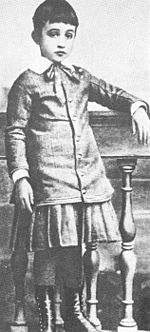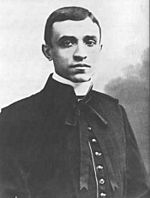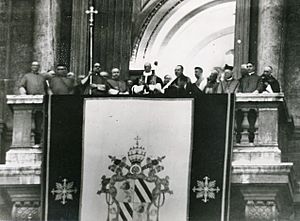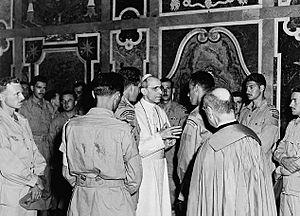Pope Pius XII facts for kids
Quick facts for kids Pope Venerable Pius XII |
|
|---|---|
| Bishop of Rome | |

Pius XII c. 1951
|
|
| Church | Catholic Church |
| Papacy began | 2 March 1939 |
| Papacy ended | 9 October 1958 |
| Predecessor | Pius XI |
| Successor | John XXIII |
| Orders | |
| Ordination | 2 April 1899 |
| Consecration | 13 May 1917 by Benedict XV |
| Created Cardinal | 16 December 1929 |
| Personal details | |
| Birth name | Eugenio Maria Giuseppe Giovanni Pacelli |
| Born | 2 March 1876 Rome, Kingdom of Italy |
| Died | 9 October 1958 (aged 82) Castel Gandolfo, Italy |
| Previous post |
|
| Education |
|
| Motto | Opus Justitiae Pax ("The work of justice [shall be] peace" [Is. 32: 17]) |
| Signature |  |
| Coat of arms |  |
| Sainthood | |
| Venerated in | Catholic Church |
| Title as Saint | Venerable |
| Other Popes named Pius | |
Pope Pius XII (born Eugenio Maria Giuseppe Giovanni Pacelli; 2 March 1876 – 9 October 1958) led the Catholic Church and Vatican City from 1939 until his death. Before becoming Pope, he worked as a diplomat for the Vatican. He served as a papal ambassador to Germany and later as the Vatican's Secretary of State. In these roles, he helped create agreements, called concordats, with different countries. One important agreement was the Reichskonkordat with Germany.
During World War II, the Vatican remained neutral. However, Pope Pius XII used diplomacy to help people suffering from the war. He also directed the Church to secretly aid Jews and others, saving many lives. He shared information with the Allies and was seen by the Nazis as someone who supported the Allies. After the war, he was succeeded by Pope John XXIII. The process to make him a saint began in 1965. He was declared Venerable in 2009.
Early Life and Education
Eugenio Maria Giuseppe Giovanni Pacelli was born in Rome, Italy, on March 2, 1876. His family was very Catholic and had strong ties to the Pope for a long time. His grandfather helped start the Vatican's newspaper, L'Osservatore Romano. His father was a lawyer for the Church, and his brother helped negotiate an important treaty for the Vatican.
Eugenio grew up in Rome with his brother and two sisters. He went to school at a convent and later to a state school. In 1894, at age 18, he began studying to become a priest. He studied theology and law at different universities in Rome. He completed his studies in 1899, earning a doctoral degree.
Church Career and Roles
Becoming a Priest and Monsignor
Eugenio Pacelli became a priest on April 2, 1899. He was ordained in a private chapel, unlike most others from Rome. Soon after, he began working at the Vatican's office for foreign affairs in 1901. This office was like the Vatican's foreign ministry.
In 1904, Pacelli earned his doctorate in canon law, which is the law of the Catholic Church. He was promoted to a higher position and became a papal chamberlain. From 1904 to 1916, he helped a cardinal write the Church's laws. He also represented the Vatican at important events, like the coronation of King George V in London in 1911. In 1914, he became the secretary of the Vatican's foreign affairs department.
Serving as Archbishop and Papal Nuncio

In 1917, Pope Benedict XV appointed Pacelli as the Vatican's ambassador, or Apostolic Nuncio, to Bavaria. He was also made an Archbishop. He traveled to Munich, Germany, and tried to help end World War I. He met with German leaders, including Kaiser Wilhelm II.
After the war, Pacelli focused on helping people, especially prisoners of war. He later moved his office to Berlin in 1925 and became the Nuncio to all of Germany. He traveled widely, gave many speeches, and met with important German politicians. He also tried to arrange diplomatic agreements between the Vatican and the Soviet Union, but these talks did not succeed.
Pacelli left Germany in 1929. He had often spoken out against the rising Nazi ideology, calling its leaders "false prophets" and "bearers of a new faith."
Cardinal Secretary of State
In 1929, Pope Pius XI made Pacelli a Cardinal. A few months later, in 1930, he was appointed Cardinal Secretary of State. This meant he was in charge of the Vatican's foreign policy and relations with other countries.
As Secretary of State, Pacelli signed many agreements, called concordats, with countries like Austria, Germany, and Portugal. These agreements helped protect the rights of the Catholic Church in those nations. For example, they allowed the Church to organize youth groups, run schools, and perform religious services.
Pacelli also made many diplomatic trips, including a major visit to the United States in 1936. There, he met President Franklin D. Roosevelt. He also presided over large Catholic gatherings in Argentina and Hungary.
Leading the Church as Pope
Election and Coronation
Pope Pius XI died in February 1939. Cardinals gathered to choose the next Pope. They chose Pacelli on March 2, 1939, which was his 63rd birthday. He was the first Cardinal Secretary of State to become Pope in over 270 years. He chose the name Pius XII to honor his predecessor.
His coronation ceremony took place on March 12, 1939. As Pope, he took on many important roles within the Church's administration.
Key Appointments and Changes
After becoming Pope, Pius XII appointed new leaders for the Vatican's departments. He also started to change the tradition of having mostly Italian cardinals. He appointed more cardinals from other countries, including China, India, and the Americas. This helped make the College of Cardinals more diverse and global.
Creating New Cardinals
Pope Pius XII held two consistories (meetings to create new cardinals) during his time as Pope. The first was in 1946, after World War II. He appointed a record 32 new cardinals, making the College of Cardinals more international than ever before. He appointed cardinals who had resisted the Nazis, as well as the first cardinals from China and India. His second consistory was in 1953. These changes ended over 500 years of Italians being the majority in the College of Cardinals.
Church Reforms and Teachings
Changes in Liturgy
Pius XII made some important changes to the Church's worship practices. In his encyclical (a papal letter) Mediator Dei, he explained the importance of liturgy. He emphasized that the Church's worship helps people connect with God and receive divine grace.
Reforms in Church Law
Pius XII also worked on reforming Canon Law, which is the set of laws governing the Catholic Church. He aimed to give more independence to the Eastern Catholic Churches. These reforms helped Eastern Catholic leaders have more control over their own churches.
Training for Priests
Pius XII introduced new requirements for the training of future priests. He added studies in social sciences, sociology, and psychology to their education. He also emphasized the need to check if candidates for the priesthood were emotionally ready for a life of celibacy and service. He added a "pastoral year" to their training, focusing on practical parish work.
Important Teachings
Understanding the Bible
In 1943, Pius XII published the encyclical Divino afflante Spiritu. This letter encouraged Catholic scholars to study the Bible more deeply. He urged them to look at the original Greek and Hebrew texts of the Bible. He also asked bishops to start Bible studies for regular church members.
Role of Theology
Pius XII clarified that theologians, who study religion, should help explain the official teachings of the Church. He said they are free to do research, but when it comes to matters of faith and morals, they should follow the Church's authority.
Beliefs about Mary
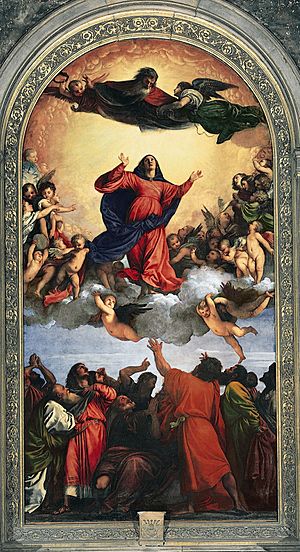
Pius XII had a strong devotion to the Virgin Mary. He was consecrated as a bishop on May 13, 1917, the same day the first apparition of Our Lady of Fátima occurred. In 1942, he consecrated the world to the Immaculate Heart of Mary.
On November 1, 1950, Pius XII used papal infallibility to define the dogma of the Assumption of Mary. This means he officially declared that Mary, after finishing her life on Earth, was taken body and soul into heaven. This was the last time papal infallibility has been used.
Science and Faith
Pius XII believed that science and religion were like "heavenly sisters" that could not truly contradict each other. He was careful not to close doors on scientific discoveries.
In 1950, in his encyclical Humani generis, he said that evolution could possibly explain how the human body developed. However, he stressed that the human soul is created directly by God. This means each person's soul is unique and spiritual.
Social Teachings
Pius XII gave many speeches to doctors and scientists. He talked about the rights of patients, the responsibilities of medical professionals, and the moral aspects of illnesses. He also discussed topics like using pain medicine for terminally ill patients.
He also taught about democracy, saying that true liberty is a moral duty and equality means everyone has the right to live honorably in their place in society.
World War II and Aid Efforts
During World War II, Pope Pius XII's main goal was to keep the Church strong and continue its mission. He tried to prevent the war from starting. Once it began, he kept the Vatican officially neutral, like Pope Benedict XV had done in World War I.
In 1939, Pius XII made the Vatican a center for aid. An office was set up to help prisoners of war and refugees. This office received millions of requests for information about missing people and provided millions of answers.
First Encyclical and War
His first encyclical, Summi Pontificatus, was issued in October 1939, just as the war began with the invasion of Poland. In it, he expressed sadness about the war and condemned antisemitism, war, and totalitarianism. He called for "compassion and help" for war victims and hoped for peace. He also spoke against the killing of innocent people.
Helping During the Holocaust
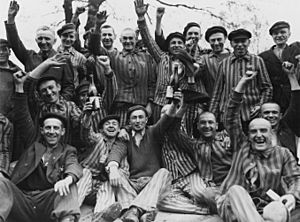
During World War II, Pope Pius XII used diplomacy to help victims of the Holocaust. He directed the Church to provide secret aid to Jews and others. When he died in 1958, many Jewish leaders praised him for what the Catholic Church did to help Jews during the war.
In his first encyclical, he spoke against racial persecution. In December 1942, he voiced concern for "hundreds of thousands" of innocent people being killed because of their "nationality or race." The Nazis saw this as an attack on their policies.
Pius XII helped Jewish scholars find jobs at the Vatican after they were fired from Italian universities due to racial laws. He also worked to get visas for "non-Aryan Catholics" to Brazil, though this program faced many challenges.
He protested against the treatment of Jews to German officials. In 1940, he asked clergy to help interned Jews. In 1942, he protested against the mass deportations of Jews from France and Slovakia.
When the Nazis occupied northern Italy in 1943, Pius XII helped hide 477 Jews in the Vatican itself. Another 4,238 Jews were protected in Roman monasteries and convents. This helped save 80% of Roman Jews from deportation.
In 1944, through his ambassador in Hungary, he urged the Hungarian government to treat Jews better. These protests, along with others from different countries, helped stop deportations there.
After World War II
After the war, Pope Pius XII focused on helping Europe recover. He also worked to make the Catholic Church more international. He encouraged Catholic missions around the world to become more independent and recognized local cultures as equal to European culture.
He appointed many new cardinals who had resisted the Nazis. He also appointed the first cardinals from China and India. He was very concerned about the spread of Communism in Europe and the Americas. He believed that poverty and hardship could lead people to support Communism. He even declared that Catholics who followed Communist ideas would be removed from the Church.
Later Life and Passing
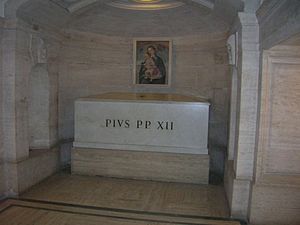
In his later years, Pope Pius XII faced health issues. He considered stepping down from his role in 1954 due to illness. He became more dependent on his close assistants. He continued to give many speeches on various topics, from ethics in medicine to the lives of saints.
Pope Pius XII passed away on October 9, 1958, at the age of 82. He suffered a stroke and then a heart failure. His last words were reportedly, "Pray. Pray that this regrettable situation for the church may end." His funeral procession in Rome was very large, with many Romans mourning their Pope.
Path to Sainthood
The process to make Pope Pius XII a saint began in 1965. In 2009, Pope Benedict XVI declared him "Venerable", which is an important step towards sainthood. However, as of 2014, the process has slowed down because no miracles have been officially attributed to his prayers.
Images for kids
-
Nuncio Pacelli in July 1924 at the 900th anniversary of the City of Bamberg
-
Nuncio Pacelli visits the coal mine Dorstfeld on the occasion of the Katholikentag in Dortmund in 1927 Germany
-
Pacelli (seated, center) at the signing of the Reichskonkordat on July 20, 1933 in Rome with (from left to right): German prelate Ludwig Kaas, German Vice-Chancellor Franz von Papen, Secretary of Extraordinary Ecclesiastical Affairs Giuseppe Pizzardo, Alfredo Ottaviani, and Reich minister Rudolf Buttmann
-
Cesare Orsenigo, Pius XII's nuncio to Germany throughout World War II, with Hitler and Joachim von Ribbentrop
-
Bishop Aloisius Joseph Muench, Pius XII's post-war liaison to the Office of Military Government, United States
See also
 In Spanish: Pío XII para niños
In Spanish: Pío XII para niños
- Cardinals created by Pius XII
- List of people from Rome
- List of popes
- List of saints canonized by Pope Pius XII
- Pius XII Memorial Library
- Pius Wars


